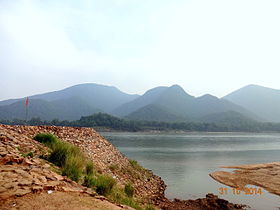Garhjat Hills
| Garhjat Range | |
|---|---|

View of the range in Binikeyee, Athmallik, Angul district
|
|
| Highest point | |
| Peak | Malayagiri |
| Elevation | 1,187 m (3,894 ft) |
| Dimensions | |
| Length | 382 km (237 mi) SW-NE |
| Width | 100 km (62 mi) |
| Geography | |
| Country | India |
| State | Jharkhand, Chhattisgarh, Odisha |
| Range coordinates | 21°22′N 85°16′E / 21.367°N 85.267°ECoordinates: 21°22′N 85°16′E / 21.367°N 85.267°E |
| Rivers | Brahmani, Mahanadi, Baitarani and Subarnarekha |
The Garhjat Hills is a mountain range formed by a series low lying hills, plateaux, ridges and meadows that stretch into Odisha from the Utkal Plains in the Chotanagpur region of Jharkhand and the Chhattisgarh Plains. The range, also known as the Odisha Highlands, runs in a north east to south west direction for about 382 km along the Odisha coast, covering 76,800 km2.
The range rises abruptly and steeply in the east and slopes gently to a dissected plateau in the west running from north-west (Mayurbhanj) to south-west (Malkangiri). The whole area is also marked by intermontane basins which cut across the region in a number of broad and narrow river valleys and flood plains. The average height of the range is about 900 metres above mean sea level.
Geographically the Garhjat Range is a northward prolongation of the Eastern Ghats. It derives its name from the Persian term for 'fort', garh. The region was named by the Mughals who conquered Odisha under Akbar. Under the Marathas too Odisha was divided into the Mughalbandhi and Garhjat provinces and the latter was ruled by 24 vassal chiefs who paid tribute to the Marathas. These states, the Orissa Tributary States, later came to be known as the Garhjat states or the Garhjats because they were located in the region of the range.
These hills cover the present day districts of Sundargarh, Sambalpur, Deogarh, Jharsuguda, Baragarh, and Kendujhar in northern Odisha.Rourkela in Sundargarh district is a major industrial town.
...
Wikipedia

